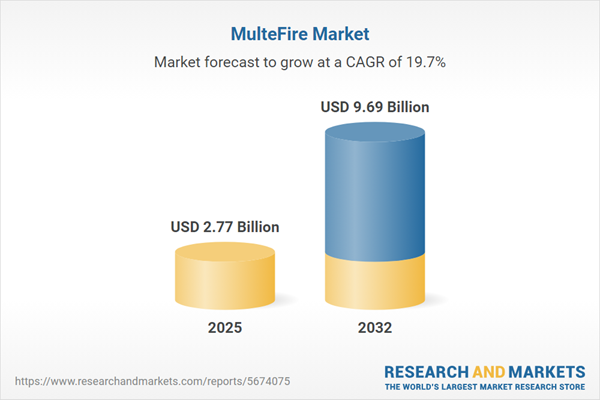Speak directly to the analyst to clarify any post sales queries you may have.
The MulteFire market is undergoing rapid transformation, presenting B2B stakeholders with critical opportunities to elevate private LTE connectivity and reduce reliance on traditional carriers. With new advancements, flexible deployment models, and updated global tariffs set to reshape cost structures, timely market intelligence is essential for enterprise decision-makers seeking technology-driven competitive advantage in enterprise wireless infrastructure.
Market Snapshot: MulteFire Market Size and Growth
The global MulteFire Market grew from USD 2.30 billion in 2024 to USD 2.77 billion in 2025. Continuing on this strong trajectory, it is expected to achieve a CAGR of 19.65% and reach USD 9.69 billion by 2032. This growth reflects widespread enterprise adoption of private LTE solutions, expanding use of unlicensed spectrum, and strong uptake across all major regions.
Scope & Segmentation
- Industry Vertical: Enterprise, Energy and Utilities, Manufacturing, Mining, Healthcare, Industrial, Retail, Transportation and Logistics
- Component: Hardware (Customer Premise Equipment, Infrastructure Equipment, Modules), Services (Deployment & Integration, Maintenance & Support), Software (Management & Orchestration, Security & Analytics)
- Deployment Mode: Indoor (Enterprise Sites, Public Venues), Outdoor (Campus Networks, City Infrastructure)
- Region: Americas (United States, Canada, Mexico, Brazil, Argentina, Chile, Colombia, Peru), Europe, Middle East, and Africa (United Kingdom, Germany, France, Russia, Italy, Spain, Netherlands, Sweden, Poland, Switzerland, United Arab Emirates, Saudi Arabia, Qatar, Turkey, Israel, South Africa, Nigeria, Egypt, Kenya), Asia-Pacific (China, India, Japan, Australia, South Korea, Indonesia, Thailand, Malaysia, Singapore, Taiwan)
- Leading Companies: Qualcomm Incorporated, Intel Corporation, Nokia Corporation, Telefonaktiebolaget LM Ericsson, Huawei Technologies Co., Ltd., Samsung Electronics Co., Ltd., Sequans Communications S.A., Fibocom Wireless Inc., Quectel Wireless Solutions Co., Ltd., Ruckus Wireless, Inc.
Key Takeaways: Strategic Insights for Senior Leaders
- The adoption of open, software-driven network architectures is enabling enterprises to control and customize private LTE deployments, supporting a diverse set of operational needs.
- Collaborations between equipment vendors, system integrators, and software providers are creating end-to-end deployment ecosystems, streamlining setup and ongoing management.
- Growing focus on edge computing allows data-intensive and latency-sensitive applications to run close to sources, which is unlocking use cases in industrial automation and real-time analytics.
- Regional regulatory alignment is expanding access to unlicensed spectrum while enabling partnerships that drive large-scale deployments, especially in smart cities and industrial parks.
- Segmentation by deployment environment and industry ensures that enterprises can match network investments to specific business objectives, from asset tracking in mining to safety management in healthcare.
- Rapid evolution of the competitive landscape is marked by strategic alliances and the development of plug-and-play solutions to accelerate private LTE adoption.
Tariff Impact: Navigating 2025 Component Cost Shifts
Forthcoming adjustments to United States tariffs in 2025 are expected to drive up hardware and module costs for private LTE deployments. Enterprises and vendors are reviewing sourcing strategies, considering nearshoring options and alternative suppliers to increase supply chain resilience. Proactive engagement between procurement and R&D teams is supporting the evaluation of new materials and design modifications, allowing organizations to manage costs while preserving network performance and deployment timelines.
MulteFire Market Research Methodology & Data Sources
This analysis draws on a multi-method approach blending in-depth interviews with operators, solution architects, enterprise IT leaders, and regulators. It is supplemented by secondary research, including reviews of technical publications, vendor briefings, and industry conference proceedings. Rigorous data triangulation, combined with expert workshops, ensures the insights capture the true complexity of market drivers and stakeholder priorities.
Why This Report Matters
- Enables senior decision-makers to benchmark their private LTE strategy, highlighting best-fit deployment models for industry-specific requirements.
- Clarifies the evolving supplier landscape and partnership opportunities, facilitating more informed sourcing and technology investment decisions.
- Positions organizations to navigate regulatory and tariff changes, optimizing procurement and accelerating returns on digital infrastructure investments.
Conclusion
The shift toward MulteFire-powered private LTE is redefining enterprise wireless strategies. Organizations that invest in modular architectures and ecosystem partnerships will enhance agility, security, and long-term competitiveness in a connected landscape.
Additional Product Information:
- Purchase of this report includes 1 year online access with quarterly updates.
- This report can be updated on request. Please contact our Customer Experience team using the Ask a Question widget on our website.
Table of Contents
3. Executive Summary
4. Market Overview
7. Cumulative Impact of Artificial Intelligence 2025
List of Figures
Samples

LOADING...
Companies Mentioned
The key companies profiled in this MulteFire market report include:- Qualcomm Incorporated
- Intel Corporation
- Nokia Corporation
- Telefonaktiebolaget LM Ericsson
- Huawei Technologies Co., Ltd.
- Samsung Electronics Co., Ltd.
- Sequans Communications S.A.
- Fibocom Wireless Inc.
- Quectel Wireless Solutions Co., Ltd.
- Ruckus Wireless, Inc.
Table Information
| Report Attribute | Details |
|---|---|
| No. of Pages | 196 |
| Published | October 2025 |
| Forecast Period | 2025 - 2032 |
| Estimated Market Value ( USD | $ 2.77 Billion |
| Forecasted Market Value ( USD | $ 9.69 Billion |
| Compound Annual Growth Rate | 19.6% |
| Regions Covered | Global |
| No. of Companies Mentioned | 11 |









